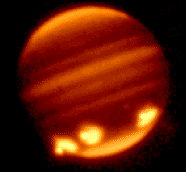 Images of the Collisions
Images of the Collisions The Comet
The Comet The Impact
The Impact

 Shoemaker/Levy 9 Collision with Jupiter CD-ROMs available
Shoemaker/Levy 9 Collision with Jupiter CD-ROMs availableFrom July 16 through July 22, 1994, fragments of Comet P/Shoemaker-Levy 9 collided with Jupiter, with dramatic effect. This was the first collision of two solar system bodies ever to be observed. Shoemaker-Levy 9 consists of 20 discernable fragments with diameters estimated at up to 2 kilometers, which impacted the planet at 60 km/s. The impacts resulted in plumes many thousands of kilometers high, hot "bubbles" of gas in the atmosphere, and large dark "scars" on the atmosphere which have lifetimes at least on the order of weeks. Smaller bits and dust continue to impact the planet. Shoemaker-Levy 9 is gone, but as the Earth- and space-based images show, it did not go quietly.
 Images of the Collisions
Images of the Collisions
 The Comet
The Comet
 The Impact
The Impact
 Hubble Space Telescope
Hubble Space Telescope
 Galileo
Galileo
 Ulysses and Voyager 2
Ulysses and Voyager 2
 International Conference on Shoemaker-Levy 9
International Conference on Shoemaker-Levy 9
 Comet and Asteroid Home Page
Comet and Asteroid Home Page NSSDCA Planetary Home Page
NSSDCA Planetary Home Page Author/Curator:
Author/Curator: